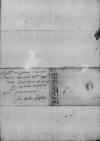Scripsi proximis litteris moram ipsam et quidquid incommodi nobis in Hispanico litore acciderat, par est, ut Tuae Excellantiae navigationis nostrae infelicis quoque certiorem reddam. Cum enim ex ⌊Hispania⌋ solvissemus, postridie eius diei maximam maris tempestatem perpessi, ut iam de salute desperaremus, tanta enim erat undarum et procellarum vis, quae undique navim implerant, ut nil aliud consilii quam in exhaurienda sentina nobis reliqui esset. Alii suarum mercium, ego vero mulae meae maioris, quam in patriam ducere statueram, eicere coacti, tredecima tandem die ⌊Angliam⌋ attigimus[2], quam relicta classe ingressus sum, contulique me per equos dispositos ⌊Londinum⌋, ubi opera et litteris domini oratoris ⌊Angliae⌋, domini ⌊Lei⌋ hospitio honestissime susceptus et tractatus fui lautissime. Deinde me ad ⌊regem⌋ contuli, cum quo (uti omnium principum est humanissimus) ad mediam horam egi donatusque fui a maiestate sua annulis aureis et argenteis,
vino praeterea ac dapibus de auratis vasis et lancibus in diversorium allatis, ita, ut mirarer tantam maiestatis suae erga me clementiam et munificentiam, hoc ipsum vero contigit opera domini ⌊Lei⌋ et domini doctoris ⌊Sampson⌋, prioris oratoris apud ⌊caesarem⌋, cuius opera hic usus sum, qui in me, ut suum erga caesarem animum) monstrare voluerunt. Obtinui itaque litteras passus ex sententia crasque hinc discedam in ⌊Flandriam⌋.
Serenissimus ⌊Angliae rex⌋ mitit ad ⌊regem Galliae⌋ ⌊cardinalem⌋, qui heri hinc magna commitiva splendid[e] ⌊Londinum⌋ egressus, rumor erat ipsum mo... regem cum ⌊Gallo⌋ conventurum ⌊Callesii⌋, nescio tamen, quid animum suae maiestatis immutaverit. ⌊Filia⌋ ⌊regis⌋, ut audio indubie, ⌊delphino⌋ desponsata est, quo fit, ut verear, ne magnum aliquod malum et maxime ob ⌊urbis⌋ tam nefariam direptionem maneat, quod Superi omen avert[ant]. Siquid novi apud ⌊Belgas⌋ intelexero, Vestrae Excellentiae quoque scribam, qui bene valeat et me
amicis communibus commendat.
Invitatus fui hic a mercatoribus ⌊Vandalis⌋, apud quos multos Tuae ⌊patriae⌋ inveni, factaque fuit honesta tuae praestantiae mentio conpotatumque ob salutem tuam, cui officio, ut istic respondeas te monere volui, et hortor sub poena excomunicationis, a qua absolvi non poteris, nisi in cena domini doctoris ⌊Liberalis⌋.
[1 ] Missing parts of address were written on lost piece of paper the seal was impressed through
[2 ] Cf. ⌊⌋ (description of the same trip)



